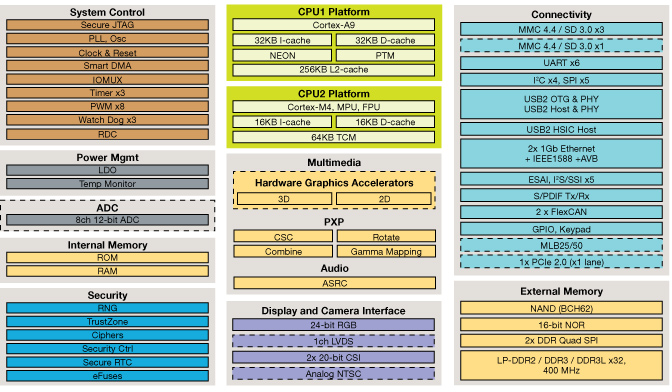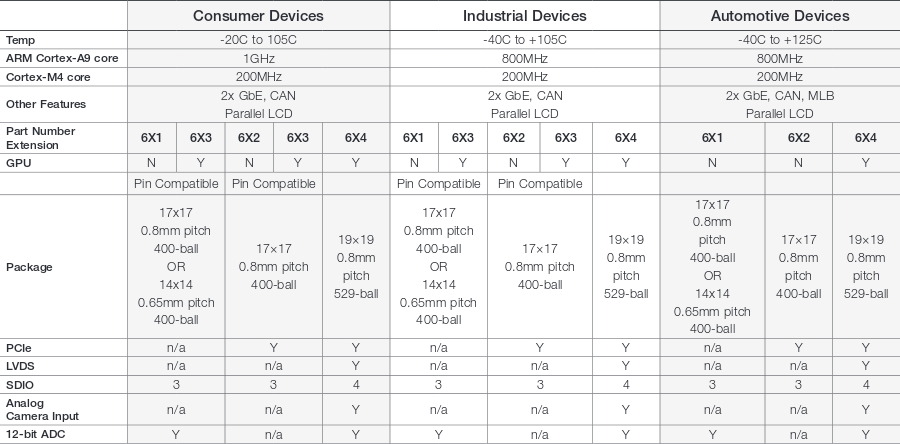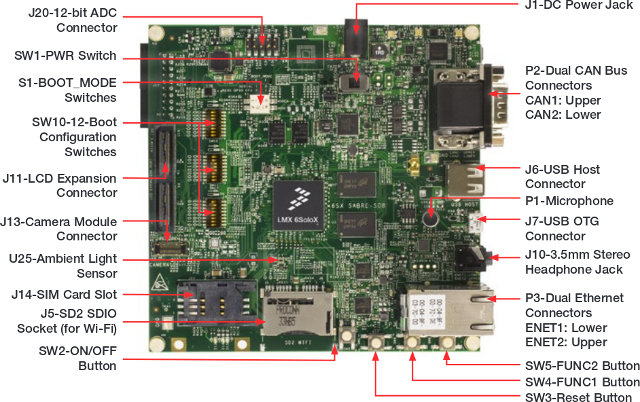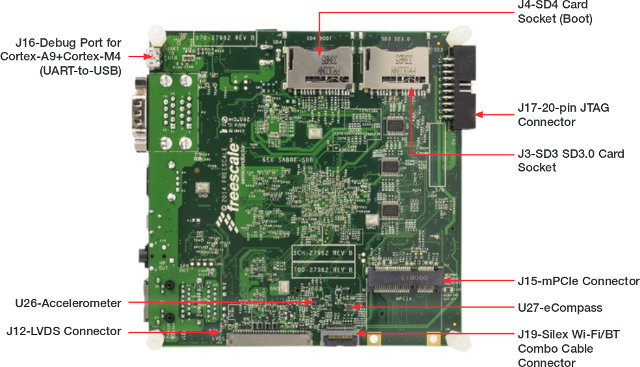Freescale i.MX6 SoloX processor started to show up in the ARM Linux Kernel mailing list last year, and Cortex A9 + Cortex M4 processor showed up in some marketing documents, but so far all documentation was tied to a non-diclosure agreement. However, all resources are now publicly available, as the company officially launched i.MX 6SoloX processor at Embedded World 2015.

Freescale i.MX 6SoloX specifications:
- CPU – ARM Cortex-A9 up to 1 GHz with 512 KB L2 cache, 32 KB instruction and data caches and NEON SIMD media accelerator
- MCU – ARM Cortex-M4 up to 200 MHz with 16 KB instruction and data caches, 64 KB TCM, MPU and FPU
- Memory Interface
- 16/32-bit DDR3-800 and DDR3L-800, 16/32-bit LPDDR2-800
- SLC/MLC NAND, 62-bit ECC, ONFI2.2
- 2x DDR Quad SPI NOR flash, 16/32-bit NOR Flash
- Display and Camera Interfaces
- Parallel RGB
- LVDS
- 20-bit parallel CMOS sensor interface
- NTSC/PAL analog video input interface
- Multimedia
- GPU – Vivante GC400T 3D GPU supporting OpenGL ES 2.0. 27Mtri/s & 133Mpxl/s and 2D GPU
- PiXel Processing Pipeline (PXP) – Image re-sizing, rotation, overlay and CSC
- I/O and Peripherals
- 2x 10/100/1000 Ethernet with \hardware AVB and support for IEEE1588
- 1x PCIe 2.0 (1 lane)
- 2x 8ch 12-bit ADC
- 3x USB 2.0 ports, 2x HS OTG + PHY, 1x HS Host HSIC
- 4x SD/MMC 4.5
- 5x SPI, 6x UART, 4x I²C, 5x I²S/SSI
- FlexCAN
- MLB 25/50
- Power management – Partial PMU integration,Freescale PF0200 PMIC
- Security
- Multicore unit includes for multi-core isolation and sharing
- Resource Domain Controller (RDC)
- Secure Messaging Unit (MU)
- Hardware Semaphores
- High Assurance Boot, cryptographic cipher engines, random number generator, and tamper detection
- Packages – 19 x 19 mm 0.8 mm BGA; 17 x 17 mm 0.8 mm BGA (two ball map options); or 14 x 14 mm 0.65 mm BGA
- Temperature Range
- Consumer (Extended Commercial) – -20C to +105C
- Industrial – -40C to +105C
- Automotive – -40C to +125C)
There are 13 i.MX 6SoloX parts divided into consumer, industrial and automotive categories with or without GPU, and different peripherals options as shown in the table below.

Documentation including datasheets, migration guide, various applications, and the full Technical Reference Manual can be freely downloaded, as well as Android 4.4.3 BSP and Linux 3.10.53 documentation. The Yocto Project has also been ported to i.MX 6SoloX (IMX6SX). The Cortex M4 core can run MQX RTOS in parallel.

The company also also launched an i.MX 6SoloX version of their SABRE development board with the following key features:
- SoC – Freescale i.MX 6SoloX Cortex A9 processor @ 1GHz with Cortex M4 MCU @ 200MHz
- System Memory – 1 GB DDR3 SDRAM
- Storage – 32 MB x2 QuadSPI Flash + 3x full-size SD/MMC card slots
- Display
- LVDS connector – Pairs with MCIMX-LVDS1 LCD display board
- LCD expansion connector (parallel, 24-bit) – Pairs with MCIMXHDMICARD adapter board
- Audio – Stereo audio codec; 1x 3.5mm audio ports
- Connectivity – 2x 10/100/1000 Ethernet ports; optional Wi-Fi module
- USB – 1x USB 2.0 Host Type A connector, 1x micro USB 2.0 OTG connector
- Other ports and I/O Expansion
- mPCIe connector
- 2x CAN (DB-9) connectors; Freescale MC34901 High-Speed CAN Transceiver
- Debugging – 20-pin JTAG connector
- Sensors – Freescale MMA8451 3-Axis Accelerometer, Freescale MAG3110 3D Magnetometer, ambient light sensor
- Power Supply – 5V
- Power Management – Freescale PF0200 PMIC

The board comes with a 5V/5A power supply, the printed quick start guide, a micro USB to USB cable, and a bootable SD card pre-loaded with a Linux image built with the Yocto Project. Android, Linux and Yocto BSP are available for the board, as well as hardware design files. Some optional hardware modules can be purchased with the board such as a 10.1″ touchscreen display (XGA resolution), an RGB to HDMI adapter, and a Wi-Fi radio card.
You can watch an overview of the board, and learn how to get started in the video below.
Freescale i.MX 6SoloX applications processors and SABRE board are both shipping in volume production, with the SoC selling for $10.84 to $13.99 in 1K quantities depending on exact SKU, and the development board priced at $399. For complete details, software and hardware documentation, visit Freescale i.MX 6SoloX and SABRE board product pages. Freescale also exhibits the solution at Embedded World, in Hall 4A, Booth 4A-220, on February 24-26, 2015.

Jean-Luc started CNX Software in 2010 as a part-time endeavor, before quitting his job as a software engineering manager, and starting to write daily news, and reviews full time later in 2011.
Support CNX Software! Donate via cryptocurrencies, become a Patron on Patreon, or purchase goods on Amazon or Aliexpress





What sucks, 1.26A @ 1.5A = 1.875W… From a single core Cortex-A9 @ 996MHz, and of course the M4 and the Vivante crud.
Almost 2Watts for that? Not even close to something to brag about, the only thing going for such small “embedded” processor system would be to run at milliwatt range, not watts.
If I’m not mistaken the Beaglebone Black has 2 embedded MCU as well (so called PRU) clocked at 200 MHz that can be programmed to access gpios and main memory. So this solution with embedded M4 mcu comes few years later without bringing anything new IMHO. It’s good to have some alternatives OTOH.
Yep, cortex-m4 is not unique here. But I am impressed by “Automotive” Cortex-A9, up to 125deg…
The Beaglebone Black’s coprocessors are pretty particular beasts, “Programmable Realtime Units.” They’re not general processors by any stretch of the imagination. Most of these interesting heterogenous core systems don’t seem to have great support for running off of the smaller core, which seems like an obvious “what on earth?” There’s a lot of peripherals on here, but I would really like to see a little more info & focus on what power consumption is. I’m not sure what anon is using to get his 1.875W draw figure, whether that’s the whole board (which I suspect) and under what conditions. But… Read more »
@rektide
Nope, directly off the chip’s datasheet (the consumer one, the IMX6SXCEC), and that is for the SoC core voltage alone, not counting in the I/O energy usages, but those are so little in overall that omitted them, just read the datasheet off the Freescale site to see for yourself.
And NXP Semiconductors announced that they are buying Freescale Semiconductor:
http://www.nxp.com/news/press-releases/2015/03/nxp-and-freescale-announce-40-billion-merger.html
NXP is a pain to get datasheets. Let’s see the impact on Freescale datasheets.
Freescale is also working on i.MX6 Plus processor with better GPU and some bug fixes, that should be ready by the end of the year. That’s all I know. Maybe they’ll have proper 1Gbit Ethernet instead of the 470Mbps limit.